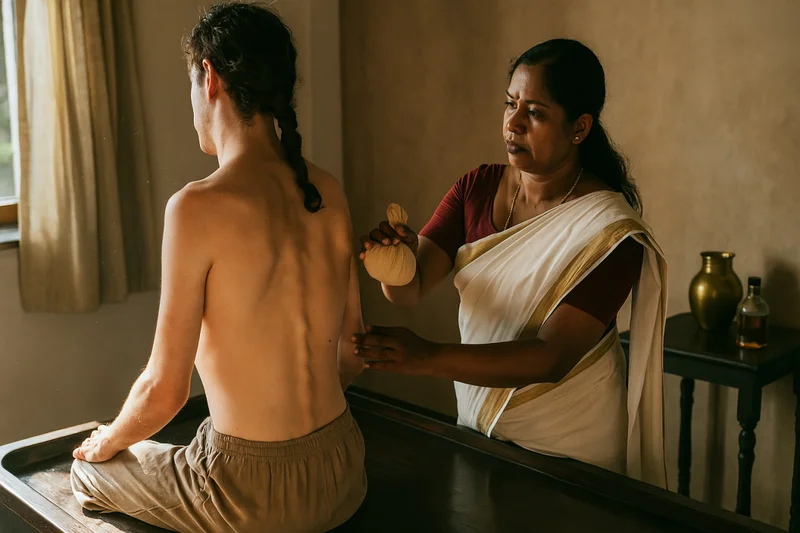Ask Ayurvedic doctor a question and get a consultation online on the problem of your concern in a free or paid mode. More than 2,000 experienced doctors work and wait for your questions on our site and help users to solve their health problems every day.
Shop Now in Our Store
Scoliosis Treatment in Ayurveda: A Holistic Approach

Scoliosis, a condition characterized by an abnormal curvature of the spine, can significantly impact one’s quality of life. Conventional treatments often focus on managing symptoms or surgical intervention in severe cases. However, Ayurveda offers a holistic, natural approach to addressing scoliosis, targeting the root causes and supporting the body’s natural healing processes.
In this article, we will explore how scoliosis treatment in Ayurveda combines herbal remedies, therapeutic massages, yoga, and dietary adjustments to provide relief and long-term benefits.
What is Scoliosis?
Scoliosis is a condition where the spine curves sideways, forming a "C" or "S" shape. It may result in:
-
Uneven shoulders or hips
-
Back pain and stiffness
-
Breathing difficulties in severe cases
-
Limited range of motion
Common causes of scoliosis include genetic predisposition, neuromuscular conditions, or congenital spinal deformities. Ayurveda aims to address these underlying factors to restore balance and improve spinal health.
How Ayurveda Addresses Scoliosis
Ayurveda views scoliosis as an imbalance in the body’s doshas – Vata, Pitta, and Kapha. The treatment plan focuses on pacifying aggravated doshas, improving circulation, and promoting musculoskeletal health. Key components include:
1. Ayurvedic Herbal Remedies
Certain herbs in Ayurveda are known to support bone health, reduce inflammation, and alleviate pain associated with scoliosis. Some effective options include:
-
Shallaki (Boswellia Serrata): Known for its anti-inflammatory properties, Shallaki helps reduce back pain and stiffness.
-
Ashwagandha (Withania Somnifera): Strengthens muscles and supports overall skeletal health.
-
Guggulu (Commiphora Mukul): Promotes joint health and reduces inflammation.
-
Dashamoola: A traditional Ayurvedic formulation that alleviates Vata imbalances and provides relief from musculoskeletal discomfort.
2. Panchakarma Therapy
Panchakarma, a detoxification therapy in Ayurveda, helps eliminate toxins and balance doshas. Specific therapies for scoliosis include:
-
Abhyanga (Therapeutic Massage): Warm herbal oils are used to relieve stiffness, improve circulation, and reduce pain.
-
Kati Basti: A specialized treatment where medicated oil is retained on the lower back to strengthen the spine and alleviate discomfort.
-
Vasti (Medicated Enema): Helps in managing Vata imbalances, which are often associated with spinal issues.
3. Yoga and Exercise
Yoga plays a crucial role in scoliosis treatment in Ayurveda. Certain postures help improve spinal alignment, strengthen muscles, and enhance flexibility. Recommended asanas include:
-
Trikonasana (Triangle Pose): Improves spinal flexibility and posture.
-
Bhujangasana (Cobra Pose): Strengthens the back muscles and relieves stiffness.
-
Marjariasana (Cat-Cow Pose): Enhances spinal mobility and reduces tension.
-
Tadasana (Mountain Pose): Improves posture and balance.
It is essential to practice these asanas under the guidance of a trained yoga instructor to prevent injury and ensure effectiveness.
4. Dietary Adjustments
A balanced diet supports overall health and strengthens bones and muscles. Ayurveda recommends:
-
Calcium-Rich Foods: Include milk, sesame seeds, and leafy greens.
-
Anti-Inflammatory Foods: Incorporate turmeric, ginger, and fresh fruits.
-
Avoid Vata-Aggravating Foods: Reduce the intake of cold, dry, and processed foods.
Benefits of Scoliosis Treatment in Ayurveda
-
Natural Pain Relief: Herbal remedies and massages alleviate pain without side effects.
-
Improved Spinal Health: Therapies like Abhyanga and Kati Basti strengthen the spine.
-
Holistic Healing: Addresses both physical and mental well-being.
-
Non-Invasive: Provides relief without the need for surgical intervention.
Precautions and Considerations
While Ayurveda offers promising results, it is crucial to:
-
Consult a qualified Ayurvedic practitioner for a personalized treatment plan.
-
Avoid self-medication with herbal remedies.
-
Practice yoga and exercises under professional guidance.
-
Monitor progress and adjust the treatment as needed.
Conclusion
Scoliosis treatment in Ayurveda provides a natural, holistic approach to managing this condition. By combining herbal remedies, Panchakarma therapies, yoga, and dietary changes, Ayurveda not only alleviates symptoms but also promotes overall spinal health and well-being. If you’re looking for a gentle yet effective way to address scoliosis, Ayurveda might be the solution you need.
Explore the ancient wisdom of Ayurveda and take the first step towards a healthier spine today!
This article is checked by the current qualified Dr Sujal Patil and can be considered a reliable source of information for users of the site.

